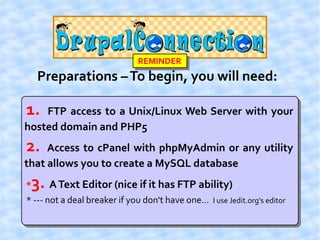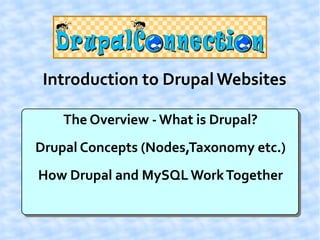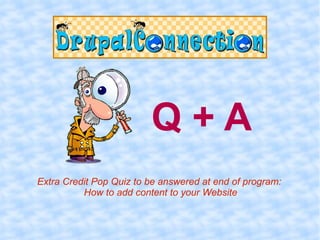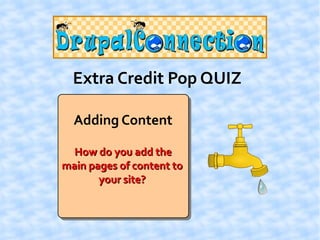Drupal 6x Installation
- 1. Drupal 6x install with basic configuration 5 Labs, 1 Quiz 1 Extra Credit POP QUIZ.... ZERO Sales Pitch! Presentation by: Michele Metts
- 2. Preparations – To begin, you will need: 1. FTP access to a Unix/Linux Web Server with your hosted domain and PHP5 2. Access to cPanel with phpMyAdmin or any utility that allows you to create a MySQL database * 3. A Text Editor (nice if it has FTP ability) * --- not a deal breaker if you don't have one... I use Jedit.org's editor
- 3. What we will cover: * Drupal Overview * Is Drupal the right choice for my project? * General Drupal Concepts and Terminology * Drupal Hosting Requirements – What do you need on your server? * Installing Drupal on your server – basic settings and configurations * The 10 most useful Modules * Meet the Drupal Community – Support, Help and Tutoring * Things you did not know Drupal could do! * Adding Content
- 4. Caveats There are many ways to do things in Drupal I am not a Database Administrator I am not a System Administrator This is not an in-depth study of Drupal Administration This is not an in-depth study of Drupal 6 Configurations This Webinar will be an overview of a basic Drupal 6 Installation.
- 5. REMINDER Preparations – To begin, you will need: 1. FTP access to a Unix/Linux Web Server with your hosted domain and PHP5 2. Access to cPanel with phpMyAdmin or any utility that allows you to create a MySQL database * 3. A Text Editor (nice if it has FTP ability) * --- not a deal breaker if you don't have one... I use Jedit.org's editor
- 6. Introduction to Drupal Websites The Overview - What is Drupal? Drupal Concepts (Nodes,Taxonomy etc.) How Drupal and MySQL Work Together
- 7. What is Drupal? Drupal is a PHP framework that can be used as a content management system. A large community of independent developers and people like yourself create modules that add features to Drupal.
- 8. Is Drupal Right for Me? Drupal is the right choice if you want a dynamic platform for a community or a user based Website that can grow and remain adaptable in today's fast paced technology market.
- 9. Is Drupal Right for Me? Yes Drupal No Drupal SEO - Drupal has many proven benefits Brochure Website Add features without writing code Static content – no updates Revisions - control of the history No Login or Registration Allow users to Tag and Upload Content None, or very few Forms Permissions control at multiple levels No site Administrators Social or Community features, blogs, forums No User Interaction Multiple customizable user roles Custom access levels Context sensitive content Community of developers for customization
- 10. Drupal Concepts There are several concepts fundamental to a Drupal site: nodes, content types, regions, blocks, views, CCK, themes, users, roles and permissions.
- 11. Nodes All pieces of content on a Drupal Website are considered "nodes." A node is any posting, page, poll, story, forum text, or blog entry. Comments are not considered nodes, although they are always related to a node. Node content is stored in the database.
- 12. Content Types Offering "content types" is a way Drupal allows you to have different kinds of nodes for different purposes. For example, a "story" is one kind of node, a "book page" another, and a "blog entry" yet another. You can also create new content types of your own.
- 13. Nodes and Content Types Labeling all pieces of content as nodes allows for flexibility when creating different types of content. You can select new and different features individually for each type of content, or add features globally to all content types. You can create menus based on content types and set access limits for individual content types – premium or standard.
- 14. Q+A Thank you for your patience. I will do my best to answer all of your questions. To stay on schedule, a limited amount of time is designated for Q + A
- 15. Introduction to the Drupal Database Creating a Database Connecting to the Database Server with Drupal Drupal settings.php, htaccess and PHP.ini Lab: Create a Database and Configure Server settings
- 16. Creating the Drupal Database 3 Steps: Log into your cPanel account and choose MySQL databse. Create database Create database user Add database user to your new database
- 17. Editing the Settings File Open your text editor and navigate to the settings file on your server. /sites/default/ Open default.settings.php Scroll down to line #92 - the section labeled “Database URL format” $db_url = 'mysql://username:password@localhost/databasename'; Edit to include the info you used to set up your database: username password databasename Save the file as settings.php See chat window for copy and paste options
- 18. Create Folders for Contributed modules and themes Navigate to your site folder /sites/all Create 2 folders inside the /all folder named: modules Themes These folders will hold your contributed modules and themes.
- 19. Drupal Core Modules Built-in Drupal Modules Enabling Optional Core Modules Configuring Core Modules Lab: Enable and configure Core required and optional modules
- 20. Installation of Drupal Modules 10 most helpful Modules Installation of Admin Module Basic Configuration of Admin Module Lab: Install and configure Admin module
- 21. Q+A Extra Credit Pop Quiz to be answered at end of program: How to add content to your Website
- 22. Navigating the Admin Screens Overview of the Admin Menu Brief Overview of Roles User Settings Logged In vs, Logged out QUIZ: Find the Modules
- 23. My 10 Favorite Modules for Admin If I could only choose 10... 1. Admin RRRRR 2. Views RRRR 3. CCK – Content Construction Kit RRRR 4. About this node RRRRR 5. Mollom RRRRR 6. CMF – Content Management Filter RRR 7. Pathauto RRRR 8. IE CSS Optimizer RRRRR 9. Admin Links RRR 10. Filter Perms RRRRR Must Have Nice to Have Want to Have
- 24. Q+A Extra Credit Pop Quiz to be answered at end of program: How to add content to your Website
- 25. Summary- Takeaway Download Drupal Create Database Installation Choose Modules Basic Configuration Navigating the Admin Screens
- 26. Q+A Extra Credit Pop Quiz to be answered in a few minutes: How to add content to your Website
- 27. Extra Credit Pop QUIZ Adding Content How do you add the main pages of content to your site?
- 28. Adding Content On the Navigation Menu: Create Content > Page Under Menu Settings, add a Menu link title, and choose <Primary Links> as the parent item. Now the page you just created will show up in the site navigation depending on how your chosen theme displays the primary links.
- 29. BONUS INFO: Things you may not know Drupal could do! Helps you configure SEO with modules Translations for navigation elements Automation of tasks and publishing SMS functionality (send SMS node notifications to subscribed users)
- 30. RECOMMENDED FREE UTILITIES FTP IMAGE EDITOR (and much more) FileZilla IrfanView URL: http://file-zilla.com/ URL: http://irfanview.com/ TEXT EDITOR DOCUMENT PROCESSING Jedit Open Office URL: jedit.org URL: openoffice.org See chat window for copy and paste options
- 31. THANK YOU FOR ATTENDING THIS WEBINAR Find a Drupal Tutor - DrupalKitchen.com For more information contact: Michele Metts micky@drupalconnection.com






























